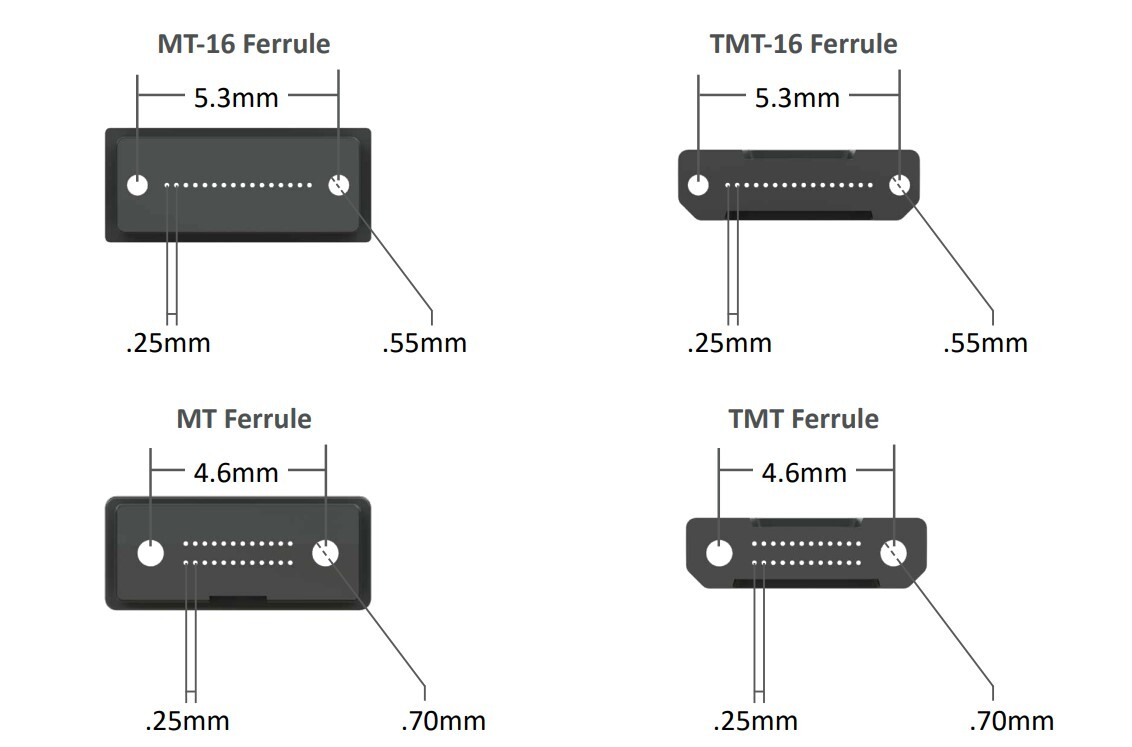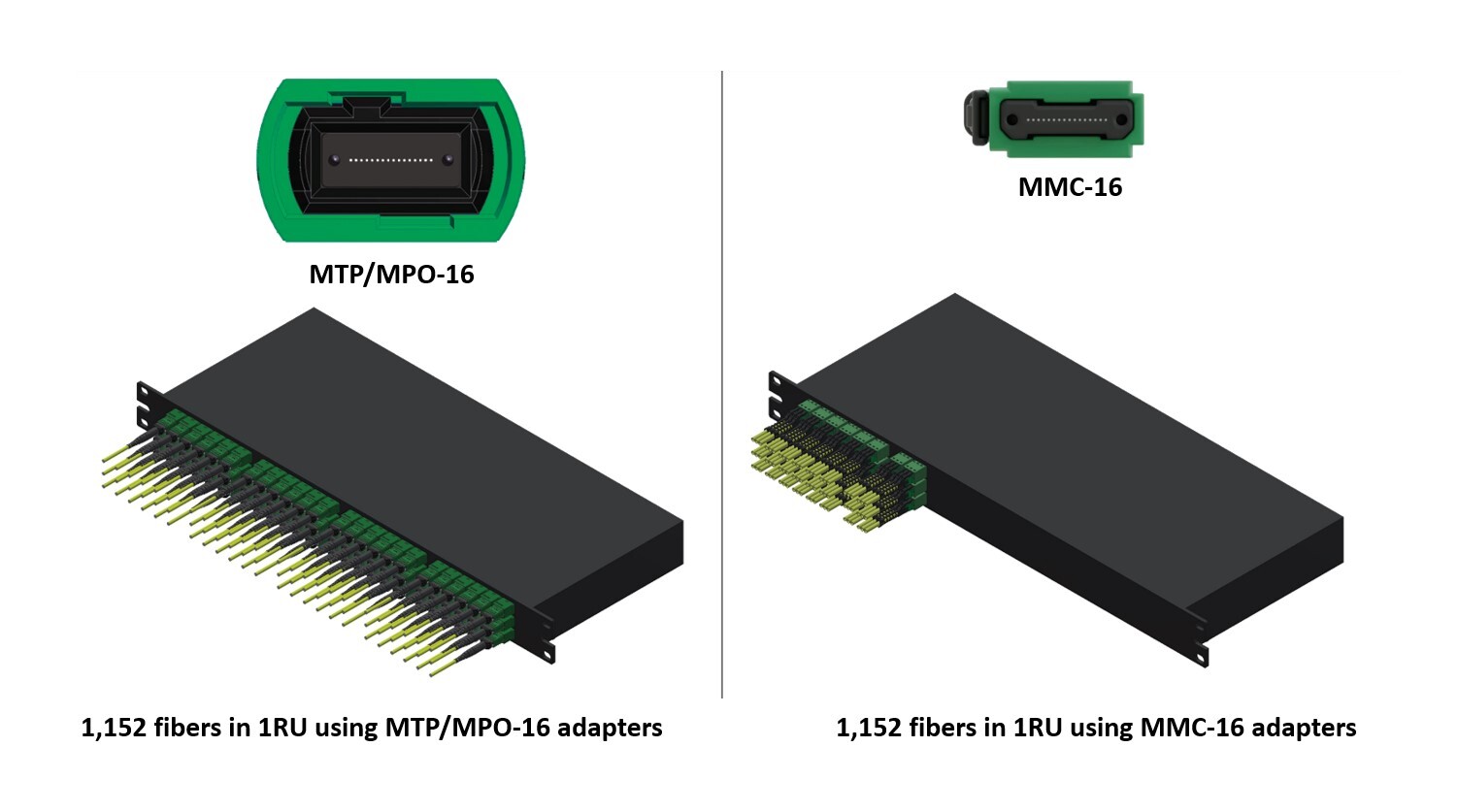MTP/MPO vs MMC: A Density Comparison
- May 19th 2025

As highlighted in our last blog, the increasing demand for high-speed parallel optics in data centers relies heavily on multi-fiber MTP/MPO cables for cost-effective transmission across multiple fibers. For example, 100, 200, and 400 Gigabit SR4, VR4, and DR4 applications utilize 8 fibers (4 transmitting and 4 receiving at 15, 50, or 100 Gb/s per lane), while 400 and 800 Gig SR8, VR8, and DR8 applications require 16 fibers (8 transmitting and 8 receiving at 100 Gb/s per lane).
While fiber count is increasing to accommodate high-speed parallel optic applications, the sheer number of connections is also increasing to support compute and storage requirements in next generation architectures designed for emerging applications like artificial intelligence (AI), machine learning, and advanced data analytics. Consider an AI cluster, which can consist of hundreds or even thousands of GPU-based nodes interconnected via 800 Gig switches to support accelerated parallel processing. These clusters also often include an additional high-speed connection per node for storage and in-band management. Even a relatively small AI cluster with only 100 interconnected GPU nodes can necessitate nearly a thousand multi-fiber connections.
Given the substantial cost per square foot and the limited availability of space, data centers require solutions that maximize computing power within their existing footprint. New very small form factor (VSFF) MMC connectors are emerging as an appealing multi-fiber alternative, gaining traction as a solution for high-density data center environments. Let's delve deeper into a comparison between traditional MTP/MPO and MMC cables.
3X More Density
Traditional MTP/MPO connectors include 12-, 16-, and 24-fiber variants that all have roughly the same basic physical dimensions of about 12.5 mm wide X 7.6 mm tall. They are available in singlemode and multimode. The MTP/MPO-16 connector features a key offset that only mate with other MTP/MPO-16 interfaces. The MTP/MPO-24 features two rows of 12 fibers.

increased fiber counts and connectivity density in next generation architectures, US Conec introduced the VSFF MMC connector. The MMC connector utilizes a new ferrule structure called the TMT ferrule, which is based on the same pin alignment structure and fiber spacing of MT ferrules used in traditional MTP/MPO technology but at about a third of the size. By using the same MT structure, MMC connectors are intermateable with MTP/MPO interfaces via hybrid adapters and compatible with existing fiber types.

Available in 12-, 16-, and 24-fiber variants in both singlemode and multimode, the MMC features a push-pull boot for easy insertion and extraction in even the most extreme dense connector environments. The MMC connectors also feature superior insertion loss performance of 0.25dB and use an angled physical contact (APC) endface geometry that reduces reflectance for better return loss performance. This is especially beneficial for short-reach DR and FR singlemode applications that leverage cost-effective, lower-power lasers, which are more susceptible to reflectance.
To demonstrate what three times more density means for a patching environment, a 1RU patch panel using MMC-16 connectors can support 216 ports (3456 fibers) while a 1RU patch panel using traditional MTP/MPO-16 connectors typically supports a maximum of 80 ports (1280 fibers).

How Are MMC Cables Used?
MTP/MPO cables take up valuable space in high density environments, especially in high-performance computing 400 Gig and 800 Gig AI architectures where every inch of rack space is extremely valuable. In these environments, pre-terminated MMC cables can be used for high-density switch-to-switch and switch-to-server connections both at interconnects and cross-connects in a structured cabling topology or as direct point-to-point connections. These smaller connectors facilitate the deployment of preterminated trunks through pathways, with more connectors accommodated within a single pulling grip.
MMC cables are often used for breakout applications. For example, cables with an MMC-16 on one end and two 8-fiber MTP/MPO connectors on the other end are ideal for connecting a single 800 Gigabit switch port to two 400 Gig ports. Consider a typical AI node with eight 400 Gig GPU ports. With MMC-16 to 2X MTP/MPO cables, a 72-port high-density 800 Gig switch can provide interconnectivity for 18 GPU nodes in an AI cluster, as shown below.

MMC-16 connectors can also be double stacked in QSFP-DD800 and dual-row OSFP-XD form factor transceivers to support 16-lane (32-fiber) 1.6 Terabit applications using current 100 Gb/s lane rates. They are also well suited for board-mounted connectors within the switch and as adapters at the front of a switch, allowing for more switch ports in a smaller chassis.
Which One is Right for You?
Deciding between MTP/MPO and MMC cables for switch-to-switch or switch-to-server connections depends primarily on your data center architecture and space constraints. If you’re a large cloud or AI service provider data center, chances are you’re already encountering every-increasing fiber densities and can benefit from MMC cables that optimize space while providing superior scalability. For example, MMC-16 cables are future ready for expanding large-scale AI deployments—they support 2X400 Gig, 800 Gig, and 1.6 Terabit (2X800 Gig) applications today, and when 200 Gb/s lane rates are introduced, they will support 4X400 Gig, 2X800 Gig, 1.6 TB, and future 3.2 Terabit (2X 1.6 TB) tomorrow.
MMC cables are also ideal for saving space in colocation data centers where every inch of rack space at the cross-connect between the meet-me room and tenant spaces is at a premium and where switch speeds are rapidly migrating to 400 and 800 Gig.
Traditional enterprise data centers where density is not a significant issue are well served by traditional MTP/MPO cables for switch-to-switch and switch-to-server links. However, it’s imperative to consider future plans. If you’re planning to embark on the AI revolution and build a high-density backend cluster, you might want to take a closer look at MMC cables.
Regardless of whether you choose traditional MTP/MPO or MMC cables for your data center, it’s essential always to consider performance and quality. Be sure to purchase only cables constructed from high-quality fiber with precision optical components, proven reliability, and superior insertion loss performance.
The good news is that CablesPlus is a premier supplier of MTP/MPO and MMC cables with the ability to custom build the length and configuration you need for your data center—all backed by our commitment to quality using only state-of-the-art precision components. As a high-density cable expert, we can also help you decide what type of cable is right for your environment. Contact us today for all MTP/MPO and MMC cabling needs.
Explore Our Complete Range of MTP/MPO Cables Contact an Expert
